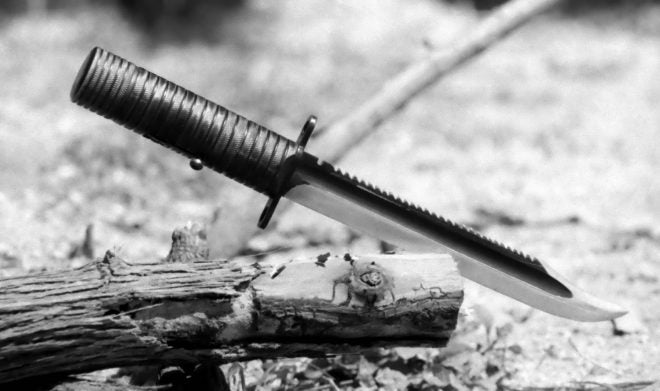Survival knives, utility knives, combat knives, shooting knives… They have appeared by the dozens in the market along the years, and for the real blade buffs today’s choices are virtually limitless. Some, of course, were one-of-a-kind examples that never reached the shops’ shelves or online catalogs at a time when WWW, as an entity, did not even exist. I’ve dug out from my personal files an example of such that appeared in Brazil in the mid-1980s. The MAD knife.
First of all, let me clarify that the curious name, in the English language, is merely the result of the combined initials of the two Brazilians who created it in the 1986, and I was lucky enough to have had the sole example completed in my hands for a few days for a closer look and some use. Having had the design patented at the time, the designers’ intention was to offer the patent rights for sale for the highest bid. Although this apparently never happened, I’ve now decided to bring this curious blade to light, using the verbs in the present tense to denote my assessment as it was at the time.

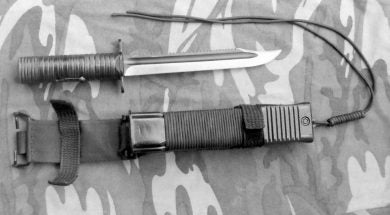
The prototype MAD knife in and out of its metal sheath.
Knife classification seems to be a very flexible proposition, so I’ll call the MAD simply a utility knife. Total length is 320mm, and the 195mm blade is 26mm wide and 5mm thick. Total weight of the knife and its components is 370g, while the overall weight of the knife/scabbard/accessories assembly reaches 650g. The blade design is much of the bayonet type, with lightening fullers (those things that are popularly – and erroneously – called “blood grooves”) and saw-spined for a full 116mm with single-tiered teeth. The crossguard is 56mm from tip to tip, compact enough so as not to foul in the user’s clothes and gear.
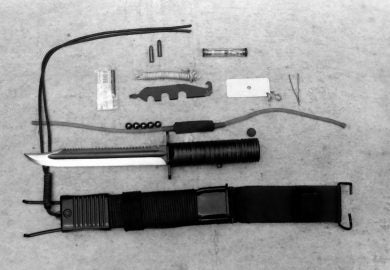
The knife, sheath, and all the goodies that comprised the package.
But it is in the handle that things start getting different. This all-aluminium part is 103mm long and has a diameter of 32mm, being knurled overall for non-slip use and with a finish in oven-cooked, black epoxy paint, also used on the top half of the blade. You would expect it to be hollow in order t house a number of accessories. Yes… and no.
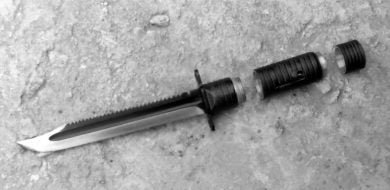
The all-aluminium handle separated into its three elements: the fixed section, near the guard, holds the tiny barrel and two individual ammo compartments; the central one features the trigger/striker, accessory tube, and slingshot pellets; the butt cap holds a small compass inside.
It is actually a three-part component. The butt cap unscrews to reveal a small compass within it and two cylindrical compartments in the rest of the handle. One of these is 12mm in diameter and houses a plastic tube containing a surgical blade, suture needle and thread, three matches with a striker, two sewing needles with cotton thread, 2.5m of 0.5mm nylon fishing line, two fish hooks and two sinkers. The other, 10mm in diameter, houses six slingshot pellets of the same caliber. This segment of the handle also contains a spring-loaded striker to… fire the knife!
The remaining of the handle, permanently attached to the blade, has individual containers for two rounds of .22LR ammunition, and a chamber/barrel. The, eh, muzzle, is one millimeter from the right side of the blade.
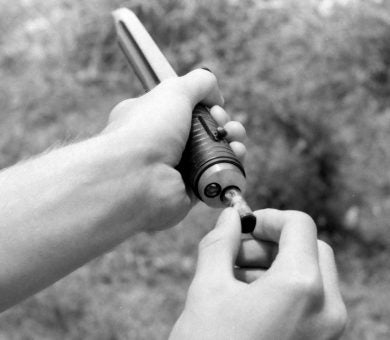
Access to the central compartment is obtained by unscrewing the butt cap. The small plastic tube being removed from the handle contains three matches with a striker, a surgical blade, suture needle and thread, two sewing needles with cotton thread, fishing line, fish hooks and sinkers (bait worms not included!).
The prototype uses a rigid sheath of steel sheet construction, to be replaced with nylon-made units in production knives. Seven meters of 2mm paracord cable for multiple uses involve it. The scabbard has a belt loop extension to which the handle is secured by a Velcro fastener, and also has a metal clip to hang it from military-style web belts. At the end, where there is a foldable slingshot, you’ll also find some nylon cable (thong) to tie the sheath to the leg so as to reduce swinging and banging as you walk around. I said ‘reduce’, not ‘eliminate’, because the whole affair is 347mm long, and will always be conspicuous, no matter how you carry it.
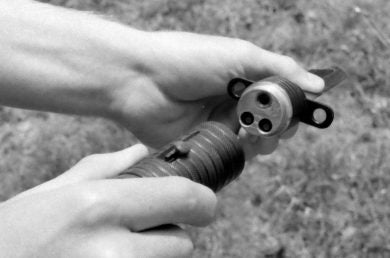
Removing the handle from the knife. Note chamber on top and two ammo compartments in the fixed section by the crossguard. Trigger is pulled into its locking recess, ready for firing.
The belt loop extension has a small Velcro-closed compartment which houses a metal signaling mirror (with inch/millimeter graduations on one side), a pencil, and some adhesive dressings. A pouch on the inner side of the sheath, snugly attached and closed with Velcro, houses the slingshot bands (which double as tourniquets), tweezers, and a simple ‘multi-tool’ featuring two sizes of screwdrivers, a bottle cap opener, three sizes (10, 11 and 12mm) of spanners, and a small saw. Two meters of 2mm diameter nylon cable are also included in said compartment.
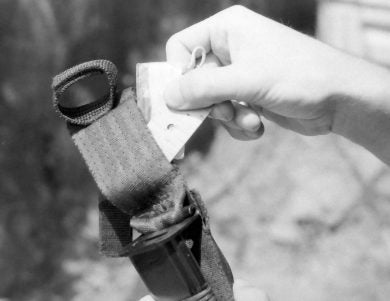
The small nylon compartment in the belt loop extension for such items as the metal signaling mirror, adhesive dressings, and pencil.
Well, so much for technicalities. Let’s go down o the serious business of firing the MAD knife (no pun intended). First of all, why the heck should one want – or need – a knife like this? Well, we’re talking about ‘survival’ situations, right? I start wondering, and figure myself coming across a small monkey on a tree above me, curiously staring at the hungry creature below… just to find itself transformed into an unforgettable dinner! Or, for those of you who appreciate hairier situations, someone physically incapable of moving out of the way of an enemy troopie walking by: he’ll only see a hopelessly disabled guy pointing a knife at him… and be shot between the eyes! Great imagination, perhaps, but not entirely impossible.
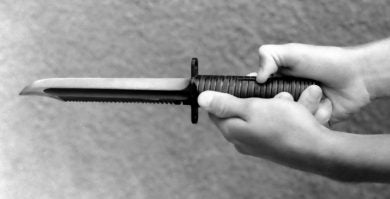
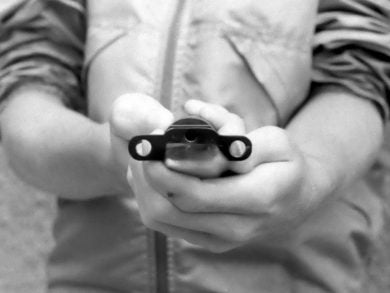
Knife in the firing position, with the thumb of the right hand about to release the trigger. The bottom picture shows its business end.
The knife should normally be carried unloaded and with the trigger/striker forward, so as not to leave the spring tensioned unnecessarily. To avoid breaking the small firing pin when unscrewing the handle, pull the trigger back against the spring and turn it into a side slot in the handle. Removing the handle should be done with the tip of the blade pointing down, otherwise a round of ammo is bound to enter the retracted bolt, thus blocking the turning movement.
Unscrew the handle, remove the cartridge from its housing, load it into the breech end, and close the handle again. The knife will fire when you flip your thumb and release the trigger, pretty much like one does when using one of those nasty pen or zip guns. The weapon’s barrel length is only 15mm, then don’t expect high grades in the accuracy department. However, trying different instinctive or rough aiming procedures, I finally came to the point of achieving consistent hits on an area roughly equivalent to a human torso at ranges of 3-5 meters, plus or minus. Recoil? Nil, as expected from the puny .22LR cartridge fired.
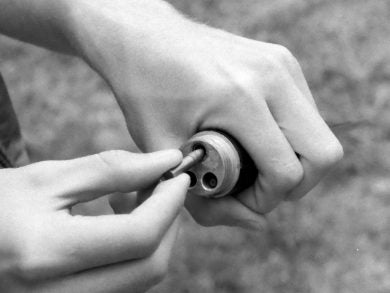
A .22LR round being inserted into the chamber for firing. Note two individual ammo compartments in the fixed part of the handle.
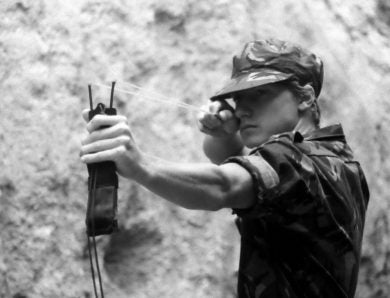
Out of ammo? A slingshot with steel pellets might come in handy for obtaining a bird for food. The teenage ‘survivor’ in photo is author’s son Alexander.
I didn’t have the time to do that, but would have loved to try setting up hunting traps with the material available – literally – at hand: the knife tied (with the nylon cables) to a tree or trunk at ‘small-game height’ and a trip wire (made with the fishing line) to let the trigger go. And tear gas cartridges (also available in .22 caliber) might even be used to set up an alarm/defense system for, say, a narrow cave entrance or door. Yup, I’ve been doing my homework, as far as watching TV is concerned!
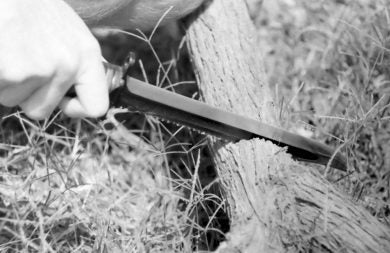
The long saw spine of the MAD knife allowed it to carry out a number of chores.
I wonder if this Ramboish contraption would have found a viable market three decades ago, or even in today’s highly sophisticated world. But be sure: I had a ball with it back then!
 Your Privacy Choices
Your Privacy Choices
